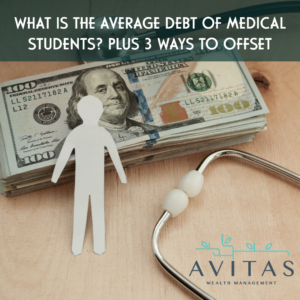 The escalating costs of medical education have become a significant concern. Aspiring medical professionals must understand and mitigate these expenses with financial literacy to avoid long-term financial burdens and maintain focus on their primary goal: providing quality healthcare.
The escalating costs of medical education have become a significant concern. Aspiring medical professionals must understand and mitigate these expenses with financial literacy to avoid long-term financial burdens and maintain focus on their primary goal: providing quality healthcare.
Medical Education And Student Debt In The U.S.
According to analysis by the Education Data Initiative, the average debt for medical students in 2023 is $250,995. This figure significantly shapes young doctors’ professional and personal lives.
Incorporating this data into the broader financial picture of medical education, a separate report mentioned that tuition fees in the U.S. average $51,812 annually at public institutions and $63,337 at private institutions.
Students must also budget for textbooks, medical equipment, and technology, which can add thousands to their total expenses. Additionally, the cost of living, especially in major urban areas, can demand a significant portion of a student’s budget.
Beyond the immediate costs, the long-term financial implications are profound. With a standard loan term of 20 years and an average interest rate of around 6%, graduates face monthly loan payments of approximately $1,800. Over two decades, this equates to a total repayment of about $430,000, comprising over $250,000 in principal and roughly $180,000 in interest. This daunting sum represents a significant commitment for young physicians, extending into midlife.
According to the American Medical Association, the average age of a first-year medical student is 24, graduating at 28 with a substantial financial burden. Loan repayments typically start just six months after graduation, at around 28.5 years old. During residency, which lasts at least three years, the AMA estimates the average income is about $60,000 annually. It translates to roughly $4,000 monthly after taxes, from which $1,800 is allocated to loan repayments, leaving only about $2,200 for other expenses.
Managing such a large debt load while earning a modest salary as a resident is a challenging part of a medical professional’s journey. Consistent and on-time payments will see an average medical graduate concluding loan repayments around age 50.
This long-term commitment underscores the need for strategic financial planning, as it will significantly influence the personal and professional aspects of a physician’s life for decades.
Strategies For Offsetting Medical Education Expenses
Apply For Scholarships and Grants
Numerous organizations and institutions offer scholarships for medical students. These can be based on academic achievement, community service, or specific medical interests. It’s crucial to research extensively and apply to as many relevant scholarships as possible to maximize your chances of receiving financial aid.
Remember to prepare strong application essays, maintain excellent academic records, and obtain compelling recommendations to stand out in your scholarship applications.
Grants are another avenue that can significantly reduce the money needed to be borrowed. Many medical schools, non-profit organizations, and government agencies provide grants to students demonstrating financial need. It’s essential to investigate these options early, as some grants require applications before the start of medical school.
Budgeting and Financial Planning
A realistic budget should include rent, utilities, groceries, transportation, insurance, and personal expenses. Budgeting tools and apps can aid in monitoring expenses and setting spending limits. It’s also beneficial to plan for unexpected costs by setting aside a portion of funds for emergencies.
Identifying areas where expenses can be reduced is crucial. It might involve choosing more affordable housing, using public transportation, cooking meals at home instead of eating out, and limiting discretionary spending on entertainment and travel.
Prioritizing financial goals is also essential. It might include setting short-term goals, like saving for board exams, and long-term goals, such as paying off student loans or saving for a medical practice. Setting clear financial goals can also help in staying focused and motivated.
Explore Income-Generating Opportunities
Although challenging due to the demanding nature of medical studies, there are ways to generate income during medical school.
Some students opt for part-time work or freelance gigs that can fit around their study schedule. Opportunities include roles in healthcare settings, such as medical scribing or working as a certified nursing assistant. Other options include tutoring, freelance writing, or other flexible remote work. The key is to find a job that offers flexibility and doesn’t interfere with academic responsibilities.
Additionally, many medical schools offer student positions as research or teaching assistants. These roles often provide a stipend and can sometimes offer tuition remission. Besides the financial benefits, these positions provide valuable experience in research and teaching, skills that benefit a medical career.
For those with a business mindset, pursuing entrepreneurial ventures can be a lucrative way to generate income. It could range from starting a small business to developing an innovative medical product or offering consulting services. Entrepreneurship may require a more significant time investment compared to other strategies but it can also offer substantial financial rewards and professional development.
Case Study: Hanna Shanar’s Initiatives – Medicine Unlocked And PubHub
Hanna Shanar, a fourth-year medical student, has made significant strides in combining his medical education with entrepreneurial ventures to offset school costs.
He founded Medicine Unlocked, an interactive and accessible non-peer reviewed publishing platform for medical students and professionals, and The Publicity Hub, a public relations and consulting firm. These ventures are alternative income sources that reduce his reliance on student loans and other traditional financial burdens.
“I began my public relations firm as a way to make some extra money while studying full time,” says Shanar in an email interview, “but it grew into something much more lucrative, opening the door for early loan repayment, investing, and additional business ventures.”
By establishing and leading these initiatives, Shanar has demonstrated how entrepreneurial skills and financial literacy can be effectively leveraged to offset the substantial costs associated with medical education.
Shanar encourages other medical students to pursue entrepreneurial endeavors while in school. “Even if you dedicate 5 to 10 hours per week, you can trim the debt you graduate with substantially. If you’re entrepreneurially savvy and are able to capitalize on that, you may be able to erase it altogether.”
Shanar’s story shows that with creativity, hard work, and strategic planning, students can find innovative ways to fund their education while contributing positively to their fields and future financial success.
Final Thoughts
While the path to becoming a physician is steeped in financial and academic challenges, it is also ripe with opportunities for innovation and strategic planning. The key lies in leveraging available resources, being financially literate, and thinking outside the box where possible to create new pathways for financial sustainability.
Ultimately, the journey is about overcoming obstacles and seizing opportunities to grow as a professional and financially savvy individual. This holistic approach will not only benefit aspiring medical professionals but will also positively impact the healthcare system and society at large.
See the article here.
By True Tamplin, Contributor at Forbes
Published December 15th, 2023
